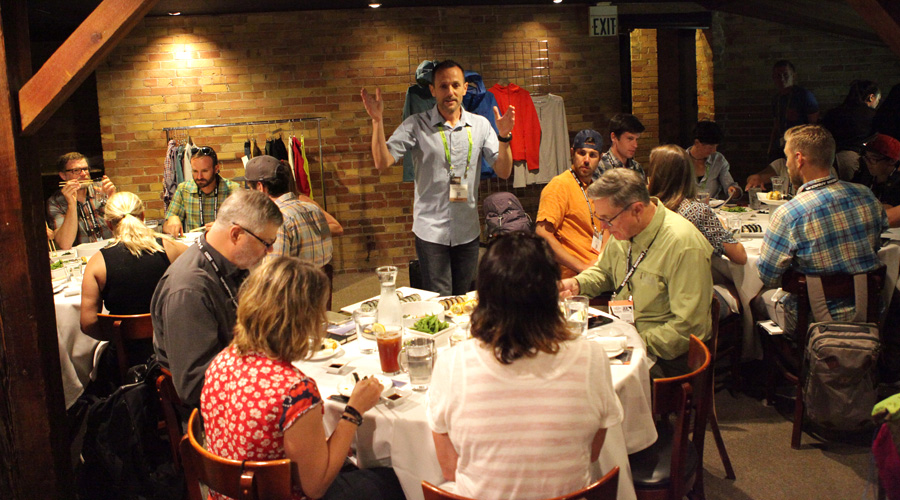The Hallways Were Packed For The First Day Of Outdoor Retailer Summer Market In Salt Lake City.
By David Clucas and Thomas J. Ryan
Walking the show floor and talking with retailers and brands, here are the major themes SGB picked up on during the early goings of ORSM.
Sustainability Driving Differentiation
While “going green” and pursuing sustainable business practices have always been staples of the industry, there seems to be a renewed push toward the efforts — in large part to differentiate outdoor products (and place them at a higher level) from the abundant active and athleisure wear in the marketplace.
In these cases, backstories are key, brands told us, and the sustainable story should begin at square one in sourcing raw materials.
Take newcomer skateboard brand Bureo, which worked with the Chilean government to set up fishing-net disposal points in 15 of the country’s coastal communities. The nets often get discarded in the ocean, contributing to roughly 10 percent of the plastic pollution problem in the waters. Bureo takes the old nets, chops them up and recycles the plastic to make boards.
“We own our whole supply chain from start to finish,” said Co-Founder David Stover. “It’s a durable, long-lasting product… and even after their lives as skateboards, we’ve pledged to take them back and recycle them again.”
Tightening Distribution and SKUs
Hand-in-hand with sustainable production practices, vendors acknowledged efforts needed to clean up distribution channels and SKUs, e.g., the number of styles they produce.
While many brands continue to expand their outdoor lifestyle offerings, there’s also a push to pull back a notch to a brand’s core. That doesn’t mean every brand has to make extreme gear for Mount Everest, said Fjallraven North American President Nathan Dopp. Rather, they need to remain focused on who they are as a brand.
At Black Diamond, after years of rapid expansion, acquisitions and offshoring — plus the troubles those decisions came with — the brand is drastically pulling back to its core of climbing for the spring/summer seasons, spokesman John DiCuollo said.
Its apparel line has been trimmed back to focus on the sport with both technical and sportswear options. In hardgoods, the brand is offering just climbing packs — no more hiking packs — and expanding into kids climbing helmets and harnesses. Black Diamond is also bringing much of its metal climbing gear production back to the U.S. Despite the pullback, it will keep its headlamp and trekking pole products, DiCuollo noted, as those categories are still the brand’s top two sellers.
We heard a similar tune at Mountain Hardwear, where President John Walbrecht and Global Director of Product Merchandising and Design Robert Fry told media at a luncheon that the brand had lost its vision in the fog.
“If we don’t make the lightest gear or we don’t make it the most durable or most premium, we’re not going to make it going forward,” Walbrecht said. “Let’s do things we should, not things we could.”
Back at Fjallraven, Dopp also pointed to efforts to clean up distribution channels as retailers complain about so-called “grey market goods” — e.g., a brand’s product showing up in Costco through a third-party distributor.
“I’ve closed millions of dollars in distribution in the past six months, and it’s painful, but the right thing to do,” Dopp said. “We have to take a long-term view for the health of the brand.” Most of the channels being cut off were online, non-brick-and-mortar and difficult-to-verify distributors, he said.
The ‘Upper’ Gets Some Love
In footwear, the emphasis continues to be on ever-lighter shoes while poking around for innovative ways to continue to offer support. Running brands such as New Balance and Brooks Running Company are using more data to design better shoes based on runner biomechanics. They’re also ramping up efforts to offer a wider array of styles that deliver various running experiences; however, the big effort to improve comfort and save weight is around the upper, said Brice Newton, senior manager of global footwear merchandising for Brooks.
Newton said knit construction is currently driving innovation around uppers, and after years of footwear designers focusing on the outsole and midsole amid the minimal and maximal trends, the upper is getting much-deserved and long-overdue attention. “We’re doing heavy research on materials overall,” he said. “Obviously knits are in at the moment and we’ll see them get even more performance-based, but we’re also looking into what’s after knits.”
Climbing’s Comeback
Great news for the show’s climbing brands came from a world away on Day 1 as the International Olympic Committee confirmed sport climbing as a new event for the Summer Olympics, with its debut slated for the 2020 Tokyo Games. The decision is another win for the sport, which has seen a boom in the indoor climbing scene.
Outdoor brands are scrambling to respond. Black Diamond is making gym bags, as there is an effort to convert newcomers to the outdoor world of the sport. However, this will take a huge effort in education, said Petzl Director of Marketing Dave Hugar. “There’s no doubt that we’re seeing some really strong climbers in the gym, pushing the limits of the sport…but there’s a transition that needs to occur when going outdoors,” he said. “Outside, there’s a mentorship process of learning safety with the ropes, anchors and how to place gear that I think is getting lost in the gym.”
Greg Thomsen, Managing Director at Adidas Outdoor (now called Terrex) agreed, saying the brand recently partnered with the American Alpine Club to produce safety videos that it plans to run in 175 U.S. climbing gyms that Terrex sponsors…and that was only Day 1 on the floor.
Stay tuned to SGB for more coverage of Outdoor Retailer Summer Market.
Photos by David Clucas













